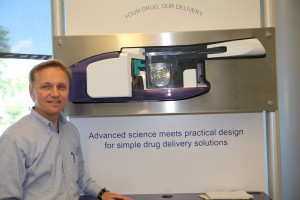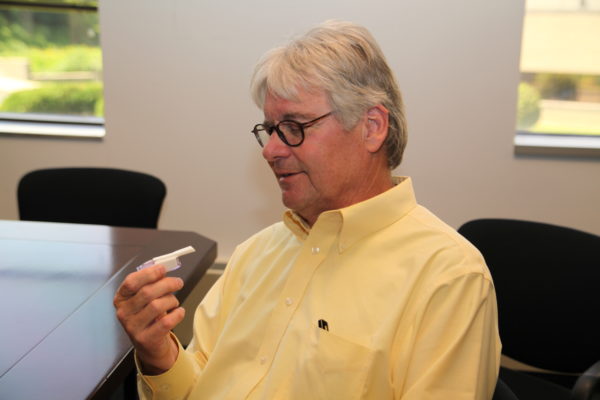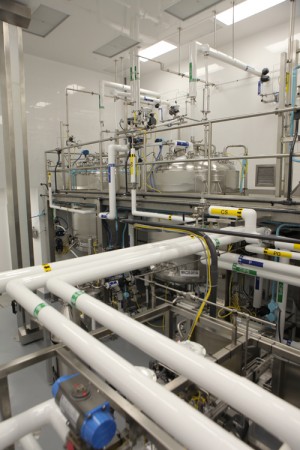Danbury’s MannKind delivers inhalable insulin
Hakan Edstrom, MannKind Corp.”™s CEO, is a patient man.
His biopharmaceutical company has the technology to turn it into a $2 billion business. However, acceptance of its patented product to deliver drugs in inhalable form has been slow. The company”™s flagship product is Afrezza, a rapid-acting insulin inhalant.
“When you start something, which is a new concept it takes some time before it kind of gets traction,” Edstrom, also the president and director, said in an interview in the company”™s Danbury office. “It is a significant change in how to provide the therapy.”
MannKind invented Technosphere, a patented technology that delivers airborne drugs. The company”™s headquarters is currently in Valencia, Calif., but Edstrom said all operations will move to Danbury within the year, where MannKind occupies two buildings, totaling 360,000 square feet. The company employs about 280 people, including manufacturers, biochemists and microbiologists.

- Joseph Kocinsky, senior vice president at MannKind next to a model of Afrezza. Photo by Danielle Brody
Because of the millions of diabetes patients and the crucial need for insulin, there was hype leading up to Afrezza”™s commercial release in February, Edstrom said. He said investors expected it to be an automatic success.
Afrezza has a competitive advantage, reaching peak concentration in the blood at least 30 minutes faster than injected insulin, Edstrom said. The small whistle-like structure allows patients to inhale insulin right before a meal, whereas with traditional therapies, patients have to time injections to a meal, leaving more potential for error.
Still, there is a learning curve for doctors and diabetes patients, Edstrom said. Edstrom admits the slow commercial success of the drug and volatile stock frustrate shareholders.
“The stock has a long way to go,” Edstrom said.
He said MannKind has a $2 billion market capitalization, a large amount for a company that”™s just starting out. MannKind shares numbered 412.3 million as of June 30. Edstrom said he does not read stock market message boards, where investors speculate the price is low and talk can turn to stock manipulation. Edstrom said he suspects the speculation comes from the slower-than-expected uptake of the drug.
In an earnings call Aug. 10, MannKind CFO Matthew Pfeffer said the federal Securities Exchange Commission is aware of the allegations and is looking into it.
Also during the call, it was announced the company was developing inhalable pulmonary hypertension and pain management drugs.
Edstrom acknowledged some investors may believe French pharmaceutical company Sanofi, Afrezza”™s marketing partner, is purposely shortchanging the company because it does not want the drug to overshadow its diabetes drugs Apidra, a mealtime insulin, and Toujeo, a long-acting insulin. He said he has seen no evidence of that.
Although Toujeo launched around the same time, the two drugs have mostly separate sales forces, Edstrom said. Sanofi and MannKind increased the spending for its direct-to-consumer campaign and also has increased the number of sales representatives.
Edstrom said Apidra is insignificant in Sanofi”™s portfolio and the company is looking to Afrezza to supplement it.
“Sanofi wants us to be successful with Afrezza, as well,” he said. “They don”™t really have a prandial (mealtime) product.”
Sanofi targeted leading endocrinologists in its first phase, then focused on high-prescribing diabetologists for phase two. Edstrom said Sanofi intentionally educated a small group of physicians to ensure the product would be used in the appropriate way. Sanofi also launched a website last month for patients and professionals as part of the Afrezza advertising campaign.
Even as Afrezza awareness increases, Edstrom said its sales have also been restrained because of the four- to six-week process for patients to get a prescription. Patients need to find an endocrinologist, get a pulmonary function test, go through a 10-day introductory trial, then see the doctor again to get the prescription.
Some doctors are not yet aware of Afrezza or when it”™s appropriate to prescribe, he said, while others are not as willing to change what they have been prescribing.
The 2007 failure of a Pfizer”™s now-defunct inhalable drug, Exubera ”” weak sales were blamed ”” also could have hurt the rollout of Afrezza in the stock market and at the doctor”™s office, he said. The tennis can-size contraption was not only embarrassing to use, nicknamed “the bong” by patients, the insulin did not reach peak concentration any faster than injected therapies, according to Edstrom.
“There is no doubt that the failure of Exubera had an impact in terms of the initial reception of our product and until you understand how our product is different and why it is different, you could expect that patients would be wondering, ”˜Well, is this a better product and why is it better?”™” he said.
Edstrom said Afrezza has had strong patient retention. Afrezza”™s best promoters are users who voluntarily praise Afrezza on social media because it has been life changing, he said.
“We just need to keep on making sure that we reach all of the patients and reach all of the physicians so they are aware of the product and know how to use it,” Edstrom said.
His goal is to help patients by continuing to use MannKind”™s Technosphere technology to build a development company with a portfolio of four to six inhalable drugs.
“In doing so I know I will please the shareholders because that will certainly be reflected in the stock,” Edstrom said. “A lot of people will make a lot of money. That is a result of being successful, but success is really providing the therapy options to the doctors and the therapy to the patients.”

